11 Tips You Need When Baking With Vegan Butter From Our Expert Plant-Based Baker
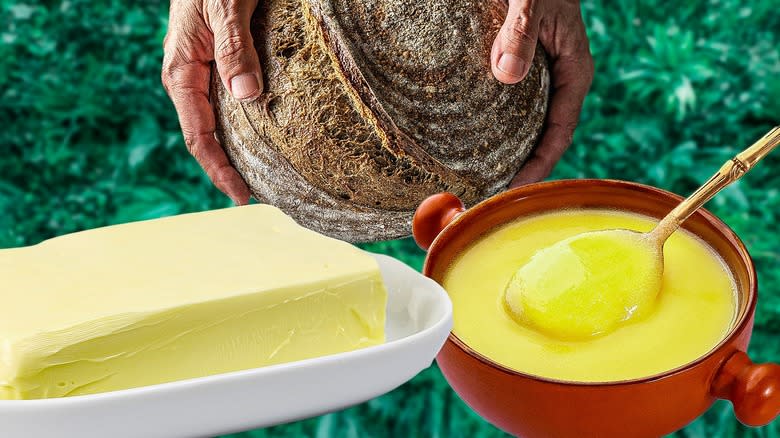
Are you trying out non-dairy baking for the first time, or just looking for ways to fine-tune your favorite plant-based recipes? What you might not know is that vegan butter acts nearly identical to regular butter, making it one of the best (and easiest) non-dairy swaps for a variety of culinary applications, including baking. As a baker who has been cooking and baking vegan recipes for well over 15 years, I've had plenty of time to practice with vegan substitutes -- and trust me, switching out butter is nowhere near as difficult as trying to find a good egg substitute. Note that vegan butter and margarine aren't the same thing -- vegan butter is entirely plant-based, whereas margarine can have small amounts of milk in it.
To me, vegan butter tastes so good that I still use it in all of my cooking -- even when regular butter is an option. After reading this article, you'll probably want to, too. Although vegan butter is very similar to regular butter, there are still a few extra things you might want to know about vegan butter before using it in your baking -- including how to substitute it, cream it, and how to find the ideal vegan butter for your baked goods. Here are a few essential tips to know when using this plant-based substitute in your cakes, cookies, and more.
Read more: The 20 Best Olive Oils For Cooking
Use A 1-To-1 Replacement Ratio
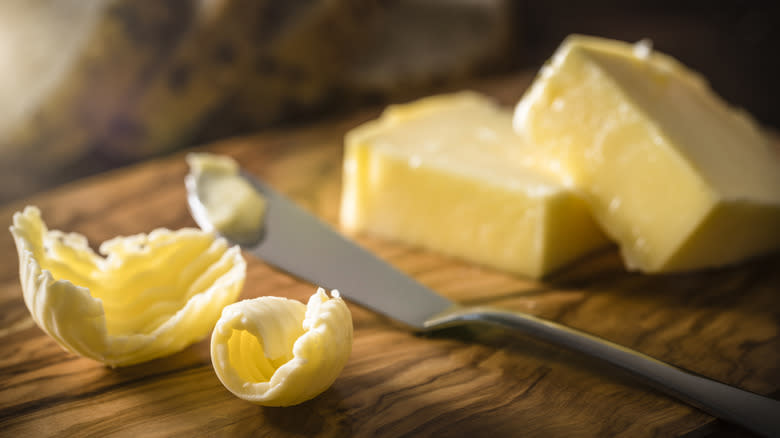
There's usually a lot of ratio conversions when it comes to subbing out ingredients in baking -- especially when you're working with non-dairy substitutes. Fortunately, the same is definitely not true for vegan butter. You can use the exact same ratio of vegan butter as you would regular butter in your baking, which makes it a 1-to-1 replacement. This makes it easy to swap out vegan butter in any recipe without having to do the math.
When you're working with other regular butter substitutes (such as cooking oil, for example), you might notice that the substitution ratio changes depending on the type and consistency of the substitute. The same isn't true with vegan butter -- you can rest assured that you'll be working with a 1-to-1 ratio every time. Vegan butters are designed across the board to be the perfect substitute for regular butter, so you won't need to do excess research before you pull out your stand mixer and kitchen tools. Like regular butter, vegan butter will either come in a tub (so you can measure it with tablespoons or cups) or in sticks (with cup and tablespoon measurements on the wrapper).
Pull Your Vegan Butter Out Of The Fridge Before Using It
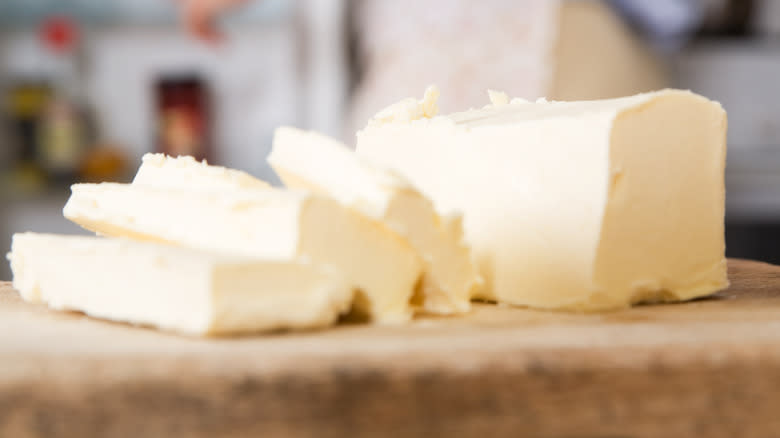
There's a theme here; vegan butter and regular butter should be treated almost the same when it comes to baking. When you're working with butter, you'll want to let it warm up before you use it. This helps to soften the butter and make it easier to use. You don't want to work with rock-hard vegan butter, whether you're blending butter into a pastry or using it for frosting. If it's cold, you'll find that it doesn't blend or cream the same as it would when it's room temperature. Even if you're able to successfully incorporate cold butter into your mix without clumping up on your mixer, you might notice that it still affects your baked goods. Cookies, for example, will come out with layers if you use cold butter, rather than the cakey, soft cookies made with room-temperature fat.
If you use vegan butter straight from the fridge, it won't mix properly. You should let it sit on the counter (covered or wrapped) on the counter for a few hours before using it. When the vegan butter feels room temperature and is slightly soft to the touch, it's ready to use. Like regular butter, vegan butter won't return to the same state it was in after it's been softened -- so if you're using a tub of butter, set aside the exact amount you want to use for baking.
Watch Your Butter's Temperature When It's Out Of The Fridge
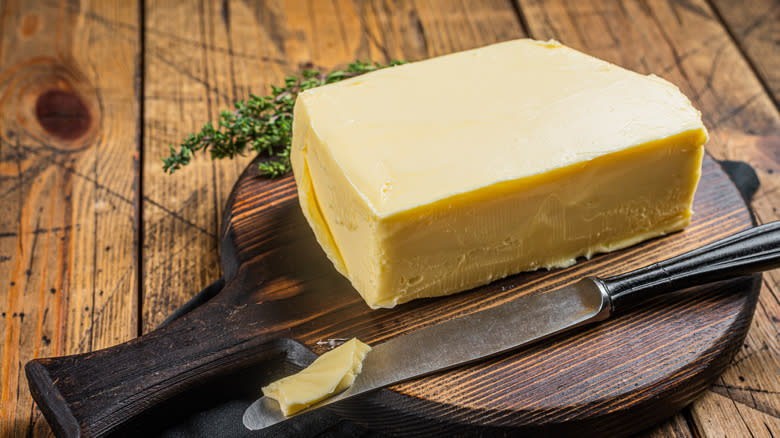
Some vegan butters will break down a bit when they're too soft. The oils will start to separate slightly, which can affect the recipe you're making. After you've let your vegan butter sit on the counter for a little bit, it should be soft enough to mix, but not separated. Unfortunately, you can't just pop your butter back in the fridge after it's melted. Once the oils in the butter have separated, they won't blend together again when refrigerated. If you've let your butter warm up for a bit and decided not to use all of it, you're safe to put the rest back in the fridge -- but if you've let it sit out too long, you're better off just throwing it away.
Vegan butter will usually take around the same time to melt as regular butter and should be room temperature within one or two hours. When you're letting your vegan butter rest, the timing can also depend on how warm the area you're resting it in is. Colder ambient temperatures means the butte won't warm up as fast.
Melt Your Butter Carefully

If your recipe calls for melted butter, you can melt it in the microwave. I always recommend nuking it at 10 second intervals and mixing in between so it doesn't overcook. If you hear bubbling, stop your microwave and take the butter out. Make sure you're microwaving your fat in a microwave-safe bowl without any other ingredients (unless your recipe says otherwise).
Once you see some liquid appear in the bowl, you'll want to stir the butter in between your cooking increments. This should be enough to melt the hardened butter completely in the bowl without needing to microwave it again. Stirring your butter frequently between melting it can help to prevent it from overheating.
If you're especially brave (or just low on time), you can heat your butter for between five and 15 seconds before using it instead of pulling it out of the fridge ahead of time. You'll want to err on the side of caution and keep your cook times brief to prevent overheating the vegan butter. You can poke it gently to see if it's done; if it feels slightly warm and your finger leaves an impression, it's ready to use.
You Can Substitute Vegan Butter For Oil

One useful thing about vegan butter is that it can be substituted for oil in recipes. Vegan butter is usually essentially just solid oil (along with some plant solids and other ingredients), so you'll be able to substitute vegan butter for oil using a 1-to-1 ratio. Most recipes call for a basic cooking oil (typically canola or vegetable oil), so plain vegan butter is your best bet for these kinds of substitutions.
Some vegan butters will use ingredients that match with certain kinds of oils better -- for example, vegan avocado butter may not be as great of a substitute for canola oil as regular vegan butter would be. This is because the flavor and oil makeup of a plain vegan butter will usually use palm oil and canola oil, matching regular baking oils exactly. So, if you're working with avocado butter, just make sure you're using a butter that lists palm and canola oil on its ingredients before it uses avocado oil.
If your recipe uses a different type of oil for cooking, you may not want to substitute. Chances are, the recipe is calling for a specific type of oil for a reason (if it doesn't call for a basic cooking oil like canola). Olive oil, for example, can give cake a very different flavor than canola oil (a neutral-tasting oil). Save your butter for recipes where your oil needs to be neutral-tasting.
Creaming Vegan Butter Is Simple
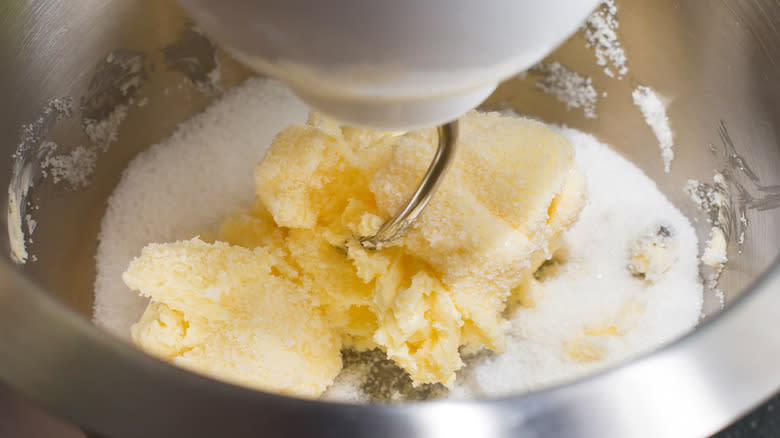
It's just as easy to cream vegan butter as it is to cream regular butter. This process involves mixing butter and sugar together, usually with an electric or stand mixer, to create a light, fluffy mixture. You might worry that the texture of your vegan butter won't reach that same fluffy, airy state as its dairy-based counterpart. But, I'm happy to report that it's simple to achieve the texture with vegan butter.
To cream your vegan butter, you'll want to mix room temperature butter with as much sugar as the recipe calls for. Your butter will be creamed in as little as three minutes, depending on how light and fluffy you want it to be. You'll also notice changes in the color and texture of your creamed butter. If you're working with a yellow vegan butter, for example, you'll start to see the vegan butter lighten in color as it's whipped. Vegan butter will absorb sugar while it's creamed just as well as regular butter would. If you find your creamed butter is still grainy, keep mixing it.
You Can Mix Vegan Butter By Hand
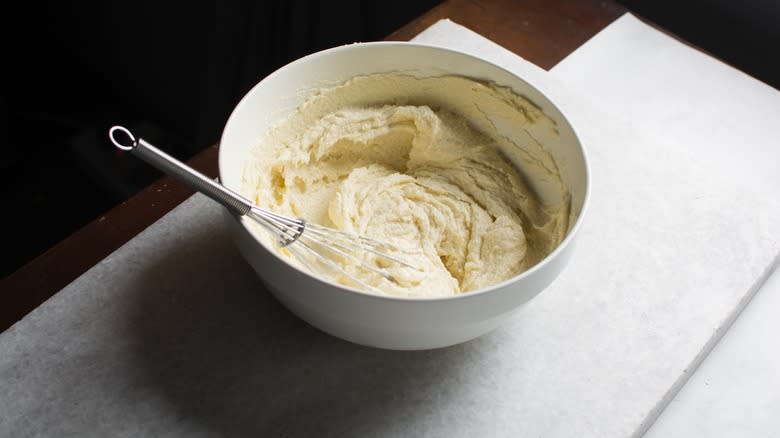
A common question when it comes to vegan butters, and butters in general, is whether or not the fat can be whipped by hand. If you don't have a stand or electric mixer, will you still be able to execute recipes that require you to cream or whip your butter? The answer, fortunately, is yes.
Because vegan butter creams easily, you can aerate it by hand when you're short a mixer (trust me, I've been there). I find that a whisk is a useful tool here, as it's most similar to what you'd see on an electric appliance. It will definitely take longer than using a stand or electric mixer, but it's worth doing by hand for recipes that call for it. Just whisk the butter as fast as you possibly can, since you're trying to imitate the speed and pattern of an electric mixer. There's no need to be gentle.
You may not be able to achieve the exact same cream by hand that you would with a mixer. For most recipes, that's perfectly fine. The main goal is to aerate the butter and help blend the sugar. Keep mixing until your butter isn't grainy and it's lightened in color a bit.
Use Vegan Butter In Your Frostings
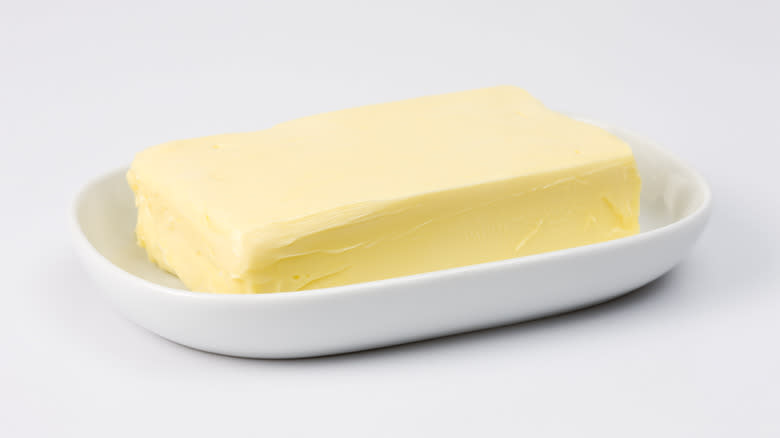
You might be concerned that using vegan butter will affect the taste of what you're baking, especially if there aren't many other ingredients to hide flavor -- as is the case with frosting. Fortunately, vegan butter tastes the same as and is texturally similar to butter, to the point where it won't be noticeable at all when you're using it to bake or frost something.
Again, you'll want to start with room temperature butter to make sure it blends nicely with the other frosting ingredients. If you're not following an exact recipe, start with a tablespoon or so of butter and add more as needed to make the frosting smoother, thicker, and stand up better (especially useful for piping). Fortunately, vegan butter is nice and stable when it comes to making frosting, so you won't need to worry about your beautifully-frosted creations melting under your watch.
Assess The Taste And Texture Of Your Butter Before You Bake With It
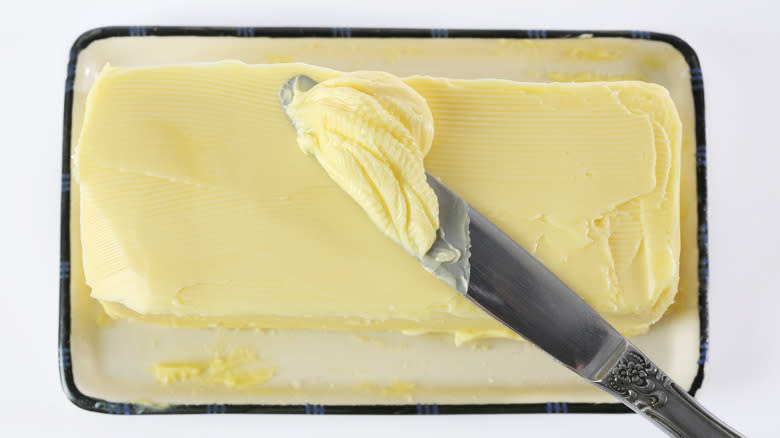
There are so many different vegan butter brands to choose from that it's tough to decide which one to grab from the grocery store. You should first consider taste when you're selecting a vegan butter. I generally try to avoid butters that taste vegetal and nutty. Sometimes, the flavor of nuts and oils can come through in a way that just doesn't happen with real butter -- but that's easily avoidable when it comes to choosing a good vegan butter.
Texture is another important element to consider. Some vegan butters are texturally different to regular butter, which could really throw you off. My personal favorite brand is Earth Balance, because it tastes exactly like real butter. It's easy to soften, mixes well, and creams nicely. One easy way to determine the taste, texture, and spreadability is to try a bit plain or on a piece of toast. That way, you can get a sense of what the butter is like before you waste a whole stick on your recipe.
When it comes to oil content, you should opt for brands that have a high oil content over ones that offer a lower amount of oils in their vegan butter. Since vegan butter is designed as an oil-based replacement for regular butter, low-oil vegan butter brands aren't actually a good substitute for regular butter or oil when it comes to baking.
Substituting Vegan Butter With Other Ingredients Is Simple
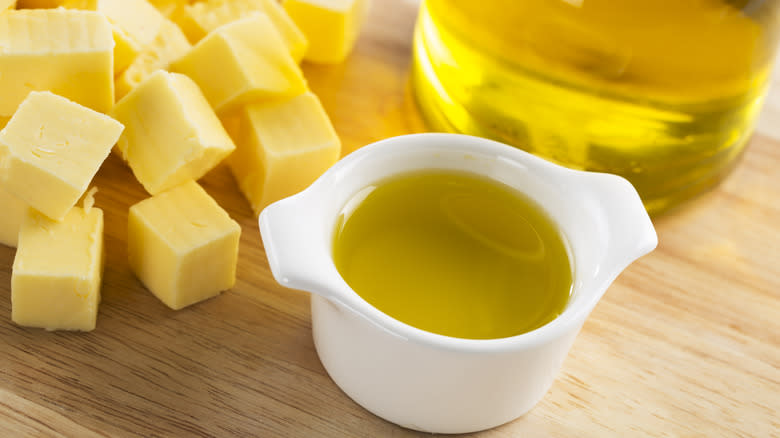
There are plenty of alternatives to vegan butter that don't involve oil, such as applesauce or plant-based yogurt. Avocado can also be a useful vegan butter substitute in baking, as long as you're using it in a recipe with other ingredients that will help to cover up its flavor. I've even used mashed banana as a butter substitute before with great success -- the flavor was easily masked by other ingredients, while the banana helped to replace the moisture and texture butter gives baking recipes.
When you're using substitutes for vegan butter, you should stick to keeping them in the main recipe itself -- if you're trying to cream butter or make frosting, for example, oil won't work as well as butter will (if you're able to achieve similar results at all). If you're using a recipe that requires you to change the texture of your butter (making it light and fluffy, for example), you might be out of luck when it comes to other substitutes.
I typically substitute vegan butter with alternatives when baking denser sweets such as cakes, brownies, or cookies. Substituting vegan butter in pastries can be a little more temperamental, so you may want to check the recipe itself to see if it offers alternative vegan substitutes. Generally, oil will always be the best butter substitute, but I would personally opt for applesauce over other substitutes if I had absolutely nothing else on hand.
Consider If You Should Use A Stick Or A Tub Of Vegan Butter
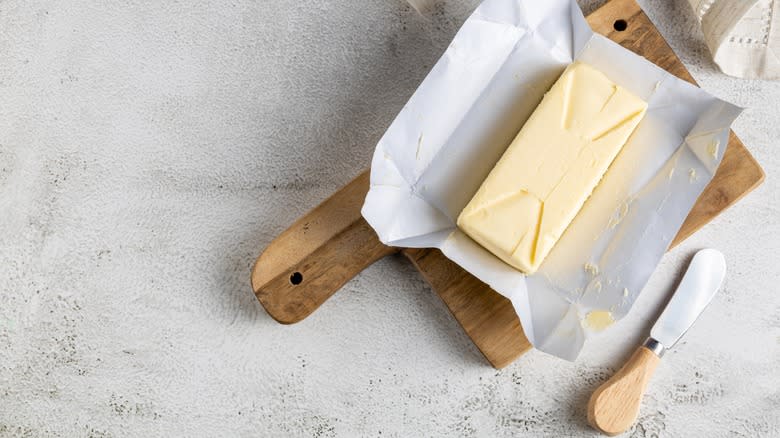
You've got plenty of options when it comes to vegan butter, and one of them is whether you want to purchase your favorite butter brand in tub or stick form. There are a few pros and cons to both forms, and you might find that it all comes down to personal preference. Even when I'm baking, I usually opt for a stick of vegan butter because it makes it easy for me to quickly grease pans or just pop the entire stick of butter in a bowl. Butter sticks come with wrapper markers, so you'll know where to cut if you want just a tablespoon.
You may find that you prefer to choose vegan butter that comes in tubs, as it can easily be scooped out in tablespoons (or cups) to use while you bake. This is handy when you're using a lot of butter at once and just don't want to deal with wrappers while you bake. I tend to find that stick butter is a little more versatile for serving as a condiment and cooking, whereas tub butter is more commonly used exclusively to cook with. Luckily, many brands offer both stick and tub versions of vegan butter, including brands like Miyoko's and Country Crock.
Read the original article on Tasting Table


